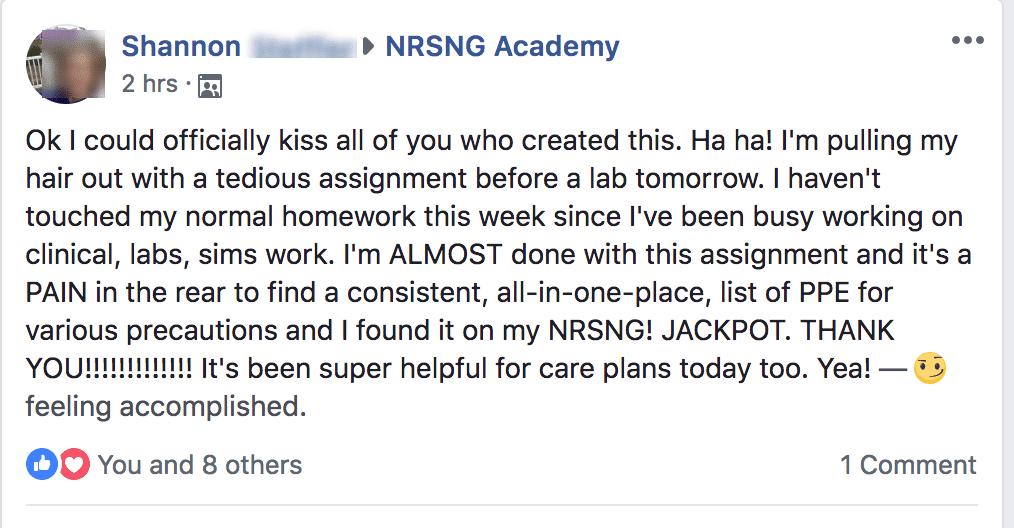This course is going to show you the most effective way to write a Nursing Care Plan and how to use Nursing Care Plans in the clinical setting. PLUS, we are going to give you examples of Nursing Care Plans for all the major body systems and some of the most common disease processes.
Care Plan Lessons: 151
Cheatsheets: 139
Questions: 411
Learn the most effective way to write a Nursing Care Plan and how to use them in a clinical setting. This lesson includes examples of …
In this lesson, you will learn the reasoning behind creating a nursing care plan. We will look at nursing care plan use during nursing school …
Overview The Nursing Process Assess Gather data Diagnose What’s the problem? Prioritize What’s most important? Plan What can I do about it? Implement DO IT! …
Overview What does this look like OUTSIDE of school? How to practicing nurses utilize Nursing Care Plans? Nursing Points General Most often NOT written Though …
Overview of Nursing Care Plan for Increased Intracranial Pressure (ICP) Think of your skull as a box that holds your brain, blood, and spinal fluid. …
Lesson Objective for Nursing Care Plan: Abdominal Pain: Upon completion of this nursing care plan for abdominal pain, nursing students will be able to: …
Lesson Objective for Nursing Care of Abortion (Spontaneous/Miscarriage) Understanding the Types of Abortion: Define and differentiate between spontaneous abortion (miscarriage) and induced abortion. Understand the …
Nursing Care Plan (NCP) for Abruptio Placentae/Placental Abruption Lesson Objective Understanding the Definition and Risk Factors: Define and comprehend the concept of abruptio placentae, …
Lesson Objective for AIDS Nursing Care Plan: Understanding of HIV/AIDS Transmission: Increase patient knowledge about the modes of transmission of the Human Immunodeficiency Virus (HIV) …
Lesson Objective for Acute Kidney Injury (AKI) Nursing Care Plan: Understanding of AKI Causes and Risk Factors: Increase awareness and knowledge about the causes and …
Lesson Objective for Acute Respiratory Distress Syndrome (ARDS) Nursing Care: Understanding ARDS Pathophysiology: Gain a comprehensive understanding of the pathophysiology of ARDS, including the mechanisms …
Lesson Objectives for Addison’s Disease (Primary Adrenal Insufficiency) Nursing Care: Understanding Pathophysiology: Comprehend the pathophysiological mechanisms underlying Addison’s disease, including the insufficient production of adrenal …
Lesson Objective for Alcohol Withdrawal Syndrome / Delirium Tremens Nursing Care: Early Recognition and Intervention: Educate healthcare providers on early recognition of signs and symptoms …
Lesson Objective for Alzheimer’s Disease Nursing Care: Understanding Alzheimer’s Disease: Develop a comprehensive understanding of Alzheimer’s disease, including its etiology, pathophysiology, and progression, to facilitate …
Lesson Objective for Anaphylaxis Nursing Care: Recognition of Anaphylactic Triggers: Identify and educate individuals at risk of anaphylaxis about common triggers, including food allergens, insect …
Lesson Objective for Nursing Care Plan (NCP) for Anemia What is Anemia? Anemia is a condition where your blood doesn’t have enough healthy …
Lesson Objective for Angina Nursing Care: Understanding Angina: Develop a comprehensive understanding of angina, including its pathophysiology, triggers, and manifestations, to facilitate accurate assessment and …
NCPIn this lesson, you will learn how to write a nursing care plan for Generalized Anxiety Disorder and the associated nursing interventions and rationales. You …
Lesson Objective for Aortic Aneurysm Nursing Care An aortic aneurysm is a serious condition involving the aorta, the largest blood vessel in the body …
Lesson Objective for Appendicitis Nursing Care Plan Recognize Signs and Symptoms: Identify the key clinical manifestations of appendicitis, including abdominal pain, nausea, vomiting, and localized …
Lesson Objective for Arterial Disorders Nursing Care Plan Understanding Arterial Disorders: Develop a comprehensive understanding of various arterial disorders, including atherosclerosis, peripheral arterial disease (PAD), …
Lesson Objectives for Aspiration Definition and Recognition: Define aspiration as the inhalation of foreign material (such as food, liquids, or gastric contents) into the airways, …
Introduction to Nursing Care Plan (NCP) for Asthma Definition of Asthma Asthma is a chronic respiratory condition characterized by bronchoconstriction, inflammation of airways, and increased …
Lesson Objective for Nursing Care Plan (NCP) for Asthma / Childhood Asthma What is Asthma? Asthma is a condition where a person’s airways …
Find a care plan on practically any disease process within the extensive (and growing) course.
All care plans are created by practicing ED/ICU nurses with Masters Degrees (like all NURSING.com content).
Each care plan lesson includes practice questions, cheatsheets, and other downloads to help you master the content.
We walk you through the creation of each care plan step-by-step so you can follow along with the expert nurse.
Nursing care plans are stressful, time consuming, and pretty much feel like a terrible waste of time. Many nursing school graduates come out of school celebrating that they will never have to write another nursing care plan.
So why did we make this course?
There is a transition that occurs during the first year or so of practicing as a nurse. By the end of their first year, the new nurse can walk into a room, do a quick survey around and know within a couple minutes exactly how the shift will go.
What has happened?
The new nurse has developed clinical thinking skills without even knowing it. They are able to build nursing care plans in their mind within just a couple of minutes.
So, while you won't be required to create long form text documents covering desired outcomes, subjective and objective data, etc . . . you will learn how to do all of that quickly as almost a sixth sense.
This course takes a different approach to nursing care plans. We do not include NIC, NOC, or NANDA . . . why? Really, you are never going to use these outside of nursing school. Instead, we take the medical diagnosis and collect subjective and objective data. With that information, we walk you through interventions you might consider in caring for the patient.
Each care plan example is developed by an expert practicing nurse who has actually taken care of similar patients. While we can't take away the pain of writing care plans in nursing school - this course is designed to help you develop clinical thinking skills that you can take with you on to the nursing floor.
Nursing care plans outline a patients most critical needs and steps of action to improve outcomes based on those needs. All of this information is backed-up with evidence and data both objective and subjective.
Care plans help a nurse prioritize actions. Once data is gathered, the nurse can begin prioritizing actions with the intent on improving the patients outcomes.
The most critical elements of a nursing care plan are:
When all of this combines, it provides a sort of game plan that allows the nurse to prioritize actions.
We suggest 5 steps for writing nursing care plans:
What you’ll notice is that the five steps align with the nursing process. While the nursing process might feel redundant in nursing school, care plans provide the perfect place to implement the steps of the nursing process.
Think of nursing care plans as the nursing process in action. The final step of the nursing process is to EVALUATE. Depending on the outcome of the evaluation phase of the nursing process determines if/when you need to update your nursing care plan. If the patient has obtained the desired outcomes, there is no need to update. However, if the patient has not yet obtained the desired outcomes, you should update the care plan.
This is how nursing works. We continually collect data on our patients and adjust our care to provide them the desired outcomes.
Subjective data is information that we gather from the patient (subject). This is data that we can not gather from charts or lab tests – the patient must share this information. In other words, you can not user your 5 senses to obtain.
Examples of subjective data:






